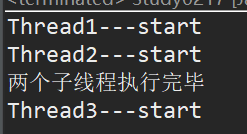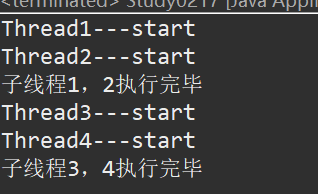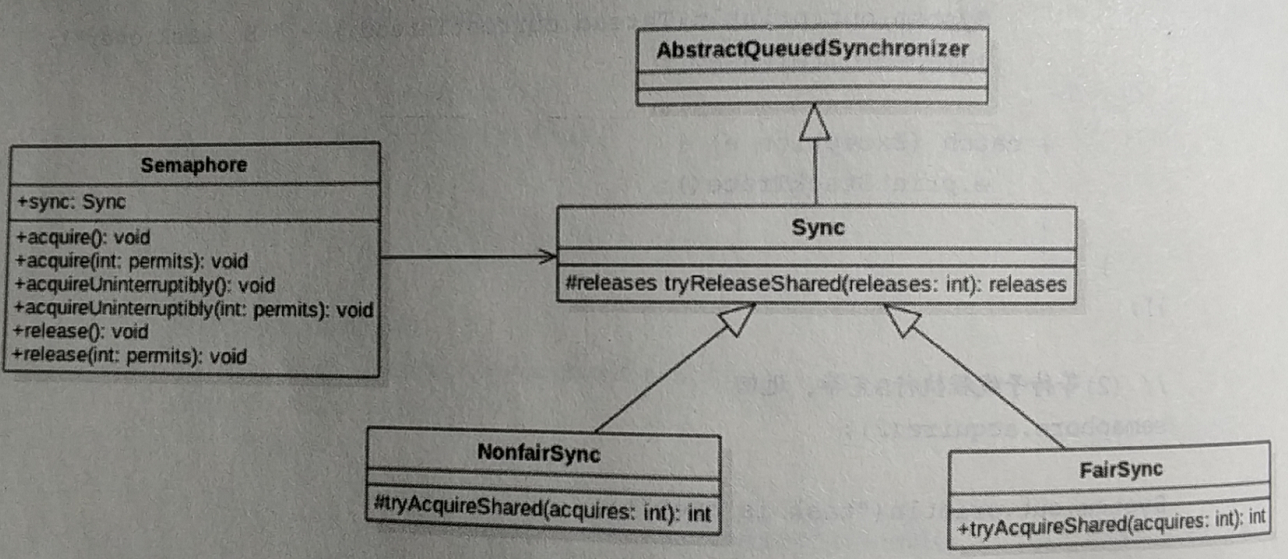Semaphore也是一個(gè)同步器,和前面兩篇說的CountDownLatch和CyclicBarrier不同,這是遞增的,初始化的時(shí)候可以指定一個(gè)值,但是不需要知道需要同步的線程個(gè)數(shù),只需要在同步的地方調(diào)用acquire方法時(shí)指定需要同步的線程個(gè)數(shù);
一.簡(jiǎn)單使用
同步兩個(gè)子線程,只有其中兩個(gè)子線程執(zhí)行完畢,主線程才會(huì)執(zhí)行:
|
1
2
3
4
5
6
7
8
9
10
11
12
13
14
15
16
17
18
19
20
21
22
23
24
25
26
27
28
29
30
31
32
33
34
35
36
37
38
|
package com.example.demo.study;import java.util.concurrent.ExecutorService;import java.util.concurrent.Executors;import java.util.concurrent.Semaphore;public class Study0217 { //創(chuàng)建一個(gè)信號(hào)量的實(shí)例,信號(hào)量初始值為0 static Semaphore semaphore = new Semaphore(0); public static void main(String[] args) throws Exception { ExecutorService pool = Executors.newFixedThreadPool(3); pool.submit(()->{ System.out.println("Thread1---start"); //信號(hào)量加一 semaphore.release(); }); pool.submit(()->{ System.out.println("Thread2---start"); //信號(hào)量加一 semaphore.release(); }); pool.submit(()->{ System.out.println("Thread3---start"); //信號(hào)量加一 semaphore.release(); }); //等待兩個(gè)子線程執(zhí)行完畢就放過,必須要信號(hào)量等于2才放過 semaphore.acquire(2); System.out.println("兩個(gè)子線程執(zhí)行完畢"); //關(guān)閉線程池,正在執(zhí)行的任務(wù)繼續(xù)執(zhí)行 pool.shutdown(); }} |

這個(gè)信號(hào)量也可以復(fù)用,類似CyclicBarrier:
|
1
2
3
4
5
6
7
8
9
10
11
12
13
14
15
16
17
18
19
20
21
22
23
24
25
26
27
28
29
30
31
32
33
34
35
36
37
38
39
40
41
42
43
44
45
46
47
48
|
package com.example.demo.study;import java.util.concurrent.ExecutorService;import java.util.concurrent.Executors;import java.util.concurrent.Semaphore;public class Study0217 { //創(chuàng)建一個(gè)信號(hào)量的實(shí)例,信號(hào)量初始值為0 static Semaphore semaphore = new Semaphore(0); public static void main(String[] args) throws Exception { ExecutorService pool = Executors.newFixedThreadPool(3); pool.submit(()->{ System.out.println("Thread1---start"); //信號(hào)量加一 semaphore.release(); }); pool.submit(()->{ System.out.println("Thread2---start"); //信號(hào)量加一 semaphore.release(); }); //等待兩個(gè)子線程執(zhí)行完畢就放過,必須要信號(hào)量等于2才放過 semaphore.acquire(2); System.out.println("子線程1,2執(zhí)行完畢"); pool.submit(()->{ System.out.println("Thread3---start"); //信號(hào)量加一 semaphore.release(); }); pool.submit(()->{ System.out.println("Thread4---start"); //信號(hào)量加一 semaphore.release(); }); semaphore.acquire(2); System.out.println("子線程3,4執(zhí)行完畢"); //關(guān)閉線程池,正在執(zhí)行的任務(wù)繼續(xù)執(zhí)行 pool.shutdown(); }} |

二.信號(hào)量原理
看看下面這個(gè)圖,可以知道信號(hào)量Semaphore還是根據(jù)AQS實(shí)現(xiàn)的,內(nèi)部有個(gè)Sync工具類操作AQS,還分為公平策略和非公平策略;

構(gòu)造器:
|
1
2
3
4
5
6
7
8
|
//默認(rèn)是非公平策略public Semaphore(int permits) { sync = new NonfairSync(permits);}//可以根據(jù)第二個(gè)參數(shù)選擇是公平策略還是非公平策略public Semaphore(int permits, boolean fair) { sync = fair ? new FairSync(permits) : new NonfairSync(permits);} |
acquire(int permits)方法:
|
1
2
3
4
5
6
7
8
9
10
11
12
13
14
15
16
17
18
19
20
21
22
23
24
25
26
27
28
29
30
31
32
33
34
35
36
37
38
39
40
41
42
43
44
|
public void acquire(int permits) throws InterruptedException { if (permits < 0) throw new IllegalArgumentException(); sync.acquireSharedInterruptibly(permits);}//AQS中的方法public final void acquireSharedInterruptibly(int arg) throws InterruptedException { if (Thread.interrupted()) throw new InterruptedException(); //這里根據(jù)子類是公平策略還是非公平策略 if (tryAcquireShared(arg) < 0) //獲取失敗會(huì)進(jìn)入這里,將線程放入阻塞隊(duì)列,然后再嘗試,還是失敗的話就調(diào)用park方法掛起當(dāng)前線程 doAcquireSharedInterruptibly(arg);}//非公平策略protected int tryAcquireShared(int acquires) { return nonfairTryAcquireShared(acquires);}final int nonfairTryAcquireShared(int acquires) { //一個(gè)無限循環(huán),獲取state剩余的信號(hào)量,因?yàn)槊空{(diào)用一次release()方法的話,信號(hào)量就會(huì)加一,這里將 //最新的信號(hào)量減去傳進(jìn)來的參數(shù)比較,比如有兩個(gè)線程,其中一個(gè)線程已經(jīng)調(diào)用了release方法,然后調(diào)用acquire(2)方法,那么 //這里remaining的值就是-1,返回-1,然后當(dāng)前線程就會(huì)被丟到阻塞隊(duì)列中去了;如果另外一個(gè)線程也調(diào)用了release方法, //那么此時(shí)的remaining==0,所以在這里的if中會(huì)調(diào)用CAS將0設(shè)置到state // for (;;) { int available = getState(); int remaining = available - acquires; if (remaining < 0 || compareAndSetState(available, remaining)) return remaining; }}//公平策略//和上面非公平差不多,只不過這里會(huì)查看阻塞隊(duì)列中當(dāng)前節(jié)點(diǎn)前面有沒有前驅(qū)節(jié)點(diǎn),有的話直接返回-1,//就會(huì)把當(dāng)前線程丟到阻塞隊(duì)列中阻塞去了,沒有前驅(qū)節(jié)點(diǎn)的話,就跟非公平模式一樣的了protected int tryAcquireShared(int acquires) { for (;;) { if (hasQueuedPredecessors()) return -1; int available = getState(); int remaining = available - acquires; if (remaining < 0 ||compareAndSetState(available, remaining)) return remaining; }} |
再看看release(int permits)方法:
|
1
2
3
4
5
6
7
8
9
10
11
12
13
14
15
16
17
18
19
20
21
22
23
24
25
26
27
28
29
30
31
32
33
34
35
36
37
38
39
40
41
42
43
44
45
46
47
48
49
50
51
|
//這個(gè)方法的作用就是將信號(hào)量加一public void release(int permits) { if (permits < 0) throw new IllegalArgumentException(); sync.releaseShared(permits);}//AQS中方法public final boolean releaseShared(int arg) { //tryReleaseShared嘗試釋放資源 if (tryReleaseShared(arg)) { //釋放資源成功就調(diào)用park方法喚醒喚醒AQS隊(duì)列中最前面的節(jié)點(diǎn)中的線程 doReleaseShared(); return true; } return false;}protected final boolean tryReleaseShared(int releases) { //一個(gè)無限循環(huán),獲取state,然后加上傳進(jìn)去的參數(shù),如果新的state的值小于舊的state,說明已經(jīng)超過了state的最大值,溢出了 //沒有溢出的話,就用CAS更新state的值 for (;;) { int current = getState(); int next = current + releases; if (next < current) // overflow throw new Error("Maximum permit count exceeded"); if (compareAndSetState(current, next)) return true; }}private void doReleaseShared() { for (;;) { Node h = head; if (h != null && h != tail) { int ws = h.waitStatus; //ws==Node.SIGNAL表示節(jié)點(diǎn)中線程需要被喚醒 if (ws == Node.SIGNAL) { if (!compareAndSetWaitStatus(h, Node.SIGNAL, 0)) continue; // loop to recheck cases //調(diào)用阻塞隊(duì)列中線程的unpark方法喚醒線程 unparkSuccessor(h); } //ws == 0表示節(jié)點(diǎn)中線程是初始狀態(tài) else if (ws == 0 && !compareAndSetWaitStatus(h, 0, Node.PROPAGATE)) continue; // loop on failed CAS } if (h == head) // loop if head changed break; }} |
以最上面的例子簡(jiǎn)單說一下,其實(shí)不是很難,首先線程1和線程2分別去調(diào)用release方法,這個(gè)方法里面會(huì)將AQS中的state加一,但是在執(zhí)行這個(gè)操作之前,主線程肯定會(huì)先到acquire(2),在這個(gè)方法里面,假如默認(rèn)使用非公平策略,首先獲取當(dāng)前的信號(hào)量state(state的初始值是0),用當(dāng)前信號(hào)量減去2,如果小于0,那么當(dāng)前主線程就會(huì)丟到AQS隊(duì)列中阻塞;
這個(gè)時(shí)候線程1的release方法執(zhí)行了,于是就把信號(hào)量state加一(此時(shí)state==1),CAS更新state為一,成功的話,就調(diào)用doReleaseShared()方法喚醒AQS阻塞隊(duì)列中最先掛起的線程(這里就是因?yàn)檎{(diào)用acquire方法而阻塞的主線程),主線程喚醒之后又會(huì)去獲取最新的信號(hào)量,與2比較,發(fā)現(xiàn)還是小于0,于是又會(huì)阻塞;
線程2此時(shí)的release方法執(zhí)行完成,重復(fù)線程一的操作,主線程喚醒之后(此時(shí)state==2),又去獲取最新的信號(hào)量發(fā)現(xiàn)是2,減去acquire方法的參數(shù)2等于0,于是就用CAS更新state的值,然后acquire方法也就執(zhí)行完畢,主線程繼續(xù)執(zhí)行后面的代碼;
其實(shí)信號(hào)量還是很有意思的,記得在項(xiàng)目里,有人利用信號(hào)量實(shí)現(xiàn)了一個(gè)故障隔離,什么時(shí)候我可以把整理之后的代碼貼出來分享一下,還是很有意思的,就跟springcloud的熔斷機(jī)制差不多,場(chǎng)景是:比如你在service的一個(gè)方法調(diào)用第三方的接口,你不知道調(diào)不調(diào)得通,而且你不希望每次前端過來都會(huì)去調(diào)用,比如當(dāng)調(diào)用失敗的次數(shù)超過100次,那么五分鐘之后才會(huì)再去實(shí)際調(diào)用這個(gè)第三方服務(wù)!這五分鐘內(nèi)前調(diào)用這個(gè)服務(wù),就會(huì)觸發(fā)我們這個(gè)故障隔離的機(jī)制,向前端返回一個(gè)特定的錯(cuò)誤碼和錯(cuò)誤信息!
以上就是詳解Java 信號(hào)量Semaphore的詳細(xì)內(nèi)容,更多關(guān)于Java 信號(hào)量Semaphore的資料請(qǐng)關(guān)注服務(wù)器之家其它相關(guān)文章!
原文鏈接:https://www.cnblogs.com/wyq1995/p/12319707.html















